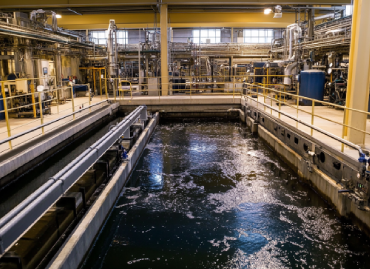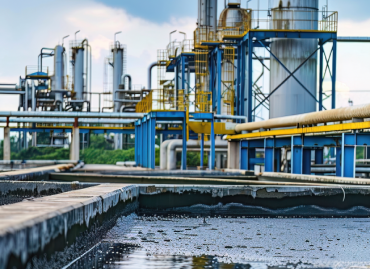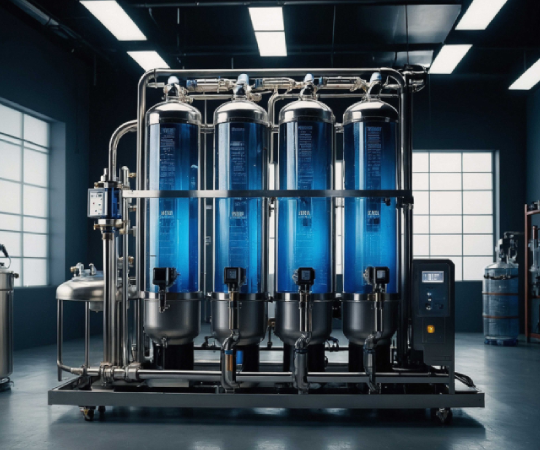- By Admin
- 12 Aug 2025
- ETP Plant
Advanced Water and Wastewater Treatment Technologies for Sustainable Textile Manufacturing and Environmental Protection
India's textile industry, one of the oldest and most vital sectors of the economy, has become a global powerhouse, producing a wide range of fabrics, garments, and textiles for export. This industry is not only significant for its economic contribution but also for the millions of people it employs across the nation. Maharashtra, a state with major textile hubs like Ichalkaranji, Solapur, and Mumbai, is at the heart of this booming industry. As the textile production scale grows to meet both domestic and international demand, the industry's reliance on water has become an increasingly important aspect of sustainable operations.
Water plays a central role in textile manufacturing, from the initial stages of fibre cleaning and spinning to the crucial processes of dyeing, washing, and finishing. However, this massive demand for water has also led to significant environmental concerns, primarily due to the large volumes of wastewater generated. Textile wastewater is often laden with dyes, chemicals, and heavy metals, requiring advanced treatment processes to minimise environmental harm and ensure compliance with regulatory standards. As the industry expands, a concerted effort is being made to optimise water use and wastewater treatment to align with sustainable practices.
"Water is the lifeblood of the textile industry, yet its management is equally crucial. Sustainable water use, efficient treatment, and smart wastewater recycling ensure that production remains efficient while minimising the environmental footprint. With every drop recycled, we not only save water but contribute to a greener, more sustainable industry."
High Water Demands in Textile Production
The textile manufacturing process is water-intensive, with various stages requiring vast amounts of water to ensure consistent quality and production efficiency. For example, in the dyeing and printing processes, water is used to dissolve dyes and chemicals, making it an essential component in achieving the desired colours and finishes. The quality of the water used directly impacts the outcome of these processes, as impurities can affect the consistency of colours and potentially damage fabrics. Consequently, maintaining a specific quality of water—low hardness, neutral pH, and free from contaminants—is essential for consistent production. Reverse Osmosis (RO) systems and softening plants are commonly deployed to purify the water, ensuring that it meets the strict quality parameters required in textile production.
While water is vital for these processes, it also generates considerable wastewater, which poses challenges in terms of both treatment and disposal. Wastewater generated from dyeing, printing, and washing processes is often rich in chemicals, colourants, surfactants, and heavy metals, making it difficult to treat. This wastewater can pose a significant threat to the environment if not properly treated before disposal or reuse.


Wastewater Challenges in Textile Manufacturing
Textile industries generate a range of wastewater streams, each with its own specific treatment challenges. The dyeing and printing processes are the primary culprits, producing water rich in chemicals, colourants, and organic matter that are difficult to degrade biologically. These effluents often contain high levels of Chemical Oxygen Demand (COD), Biological Oxygen Demand (BOD), and heavy metals such as chromium and copper. Additionally, wastewater from fabric washing, equipment cleaning, and water treatment backwashing further complicates the situation, as it often contains suspended solids and surfactants.
Given the complexity of the wastewater, textile units must adopt advanced, multi-stage treatment systems to reduce the environmental impact. Effluent Treatment Plants (ETPs) are an essential part of this process, providing a reliable method for treating and managing industrial wastewater. These systems use primary, secondary, and tertiary treatments to reduce contaminants to safe levels.
Effective Wastewater Treatment: ETPs, RO, and ZLD Systems
Effluent Treatment Plants (ETPs) are commonly employed in the textile industry to handle wastewater generated during production. The primary treatment in ETPs involves sedimentation and chemical coagulation, which removes suspended solids and reduces colour. Secondary treatments typically include biological processes such as activated sludge systems, which degrade organic matter and reduce BOD and COD levels. In tertiary treatment, techniques like activated carbon filtration, advanced oxidation, and UV disinfection are used to purify the water further before it is either discharged or reused within the facility.
To meet stringent environmental standards, many textile companies are turning to Zero Liquid Discharge (ZLD) systems. These systems use a combination of RO, evaporators, and crystallisers to recover up to 95% of the water from the effluent, leaving behind a minimal amount of waste. ZLD systems help reduce water intake, cut down treatment costs, and ensure compliance with environmental regulations.
In addition to ZLD, advanced membrane systems such as Ultrafiltration (UF) and Nanofiltration (NF) are increasingly used in textile wastewater treatment to remove colourants, heavy metals, and other contaminants. These technologies offer significant advantages in terms of water recovery and efficiency, enabling textile plants to reduce their reliance on freshwater sources.
Tailored Solutions for Sustainable Water Management
As the textile industry continues to face growing pressure to improve sustainability, companies are increasingly looking for customised water and wastewater treatment solutions. Tailored systems that meet the unique requirements of each textile unit are essential for optimising water use and ensuring environmental compliance. Companies like ours provide end-to-end solutions, including the design, installation, and maintenance of ETPs, STPs, WTPs, RO systems, and ZLD units. We also offer real-time monitoring and automation to ensure the efficiency and compliance of water treatment systems, helping textile manufacturers to achieve water sustainability while minimising environmental impact.
Summary And Conclusion
India's textile industry is a key player in the global economy, but its reliance on water and the associated wastewater challenges require effective management solutions. Advanced water treatment technologies such as RO, ETPs, and ZLD systems are essential to ensuring the industry remains sustainable while meeting environmental standards. By adopting these technologies, textile manufacturers can reduce their water consumption, minimise wastewater discharge, and contribute to a greener future. Tailored solutions for water treatment ensure that each plant's specific needs are addressed, making sustainability an achievable goal for the textile industry as it continues to grow.































































